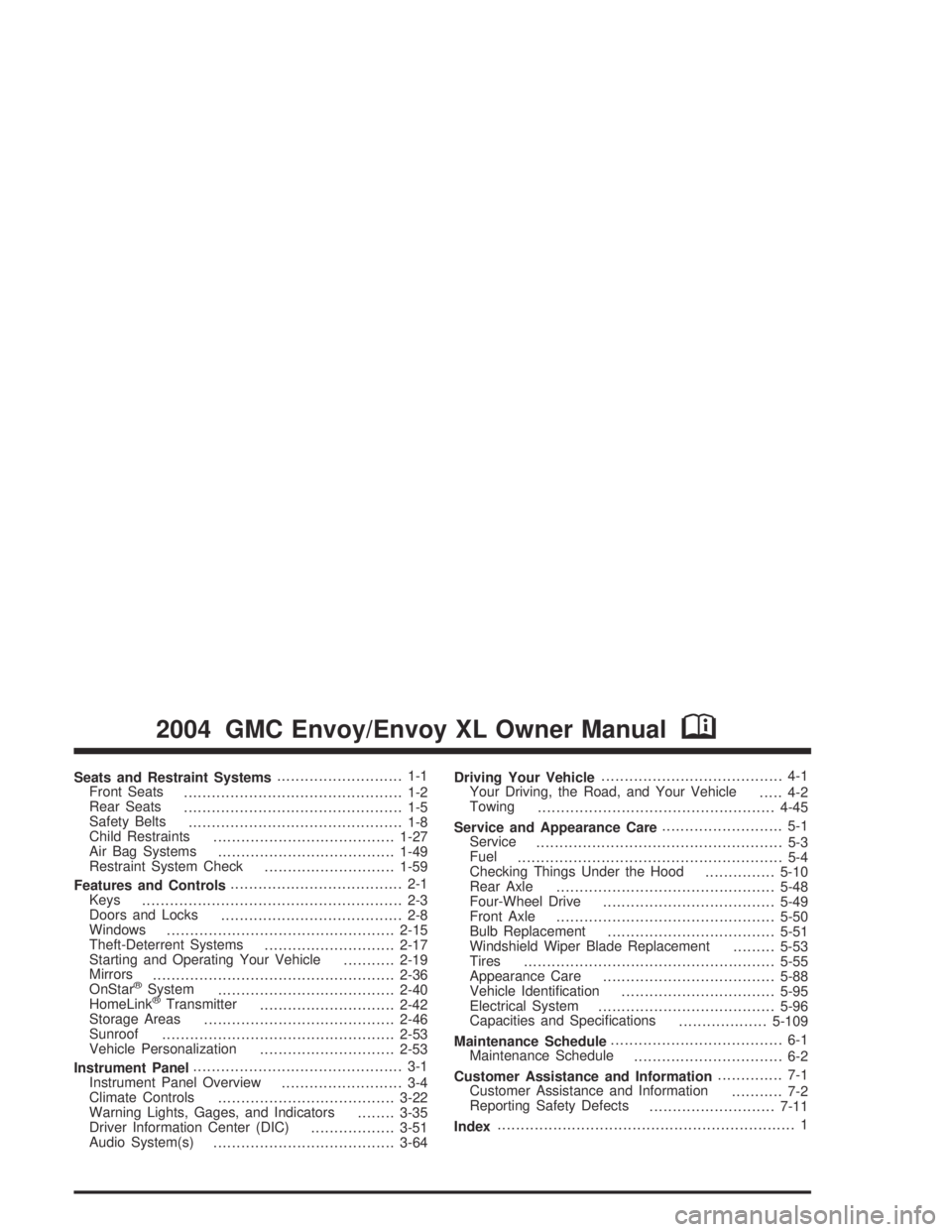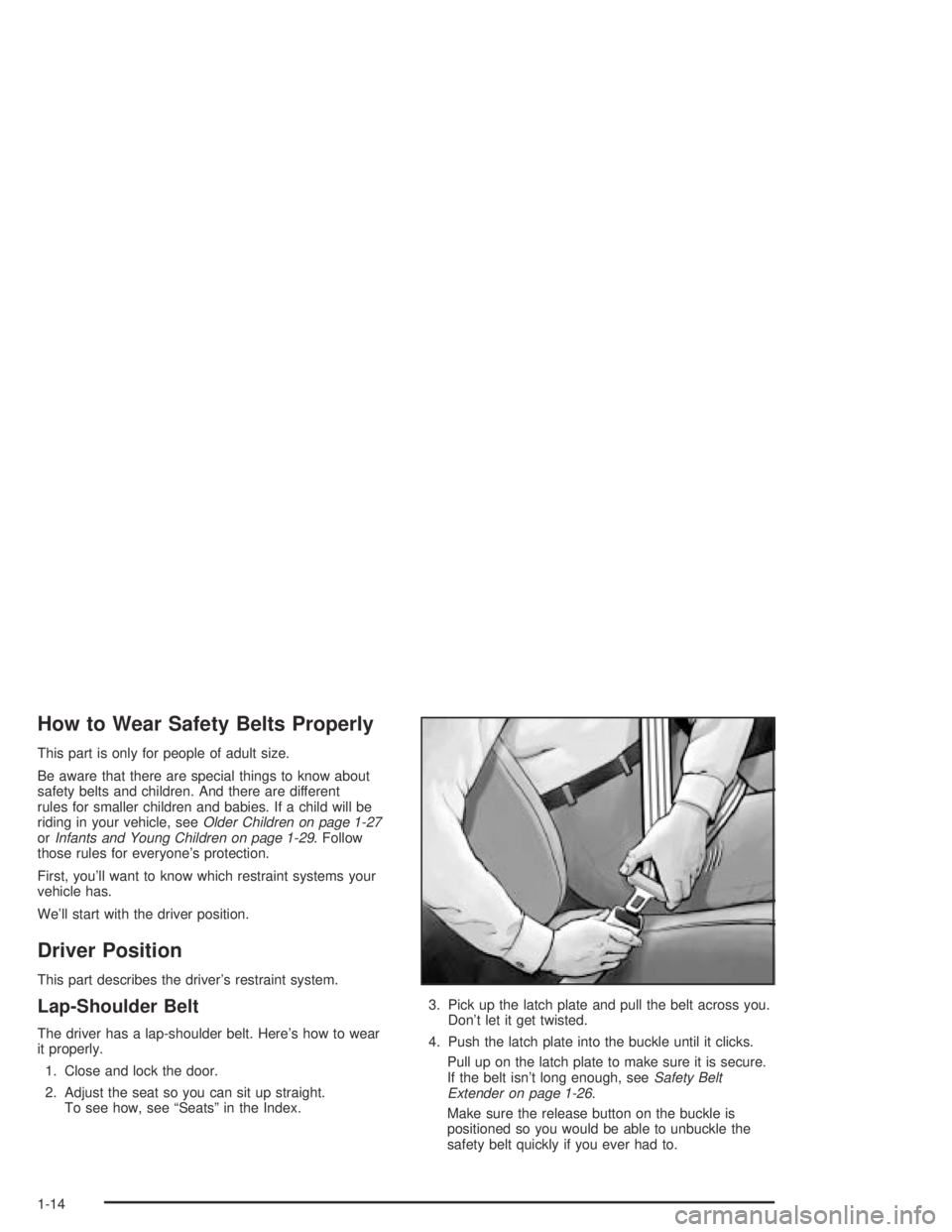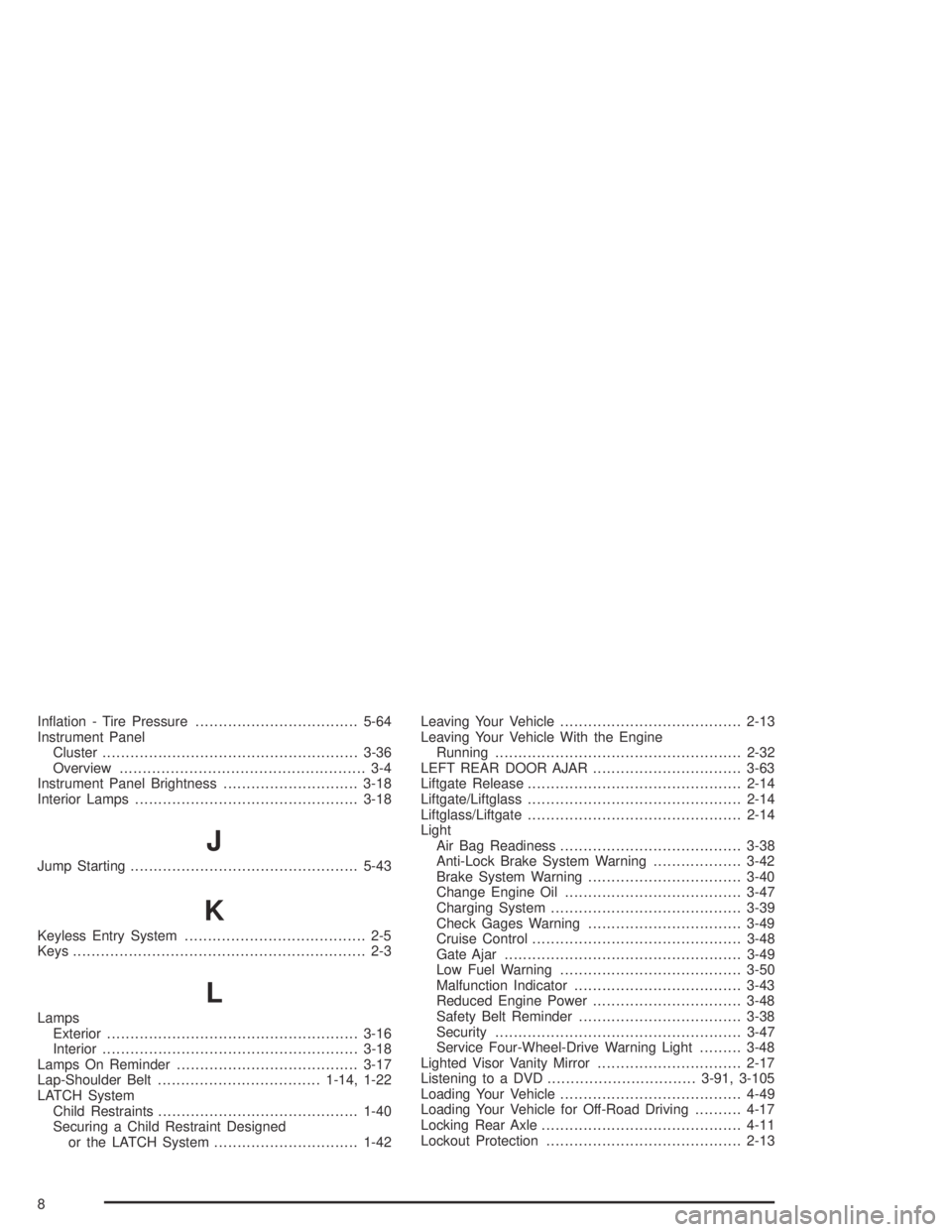child lock GMC ENVOY XL 2004 Owners Manual
[x] Cancel search | Manufacturer: GMC, Model Year: 2004, Model line: ENVOY XL, Model: GMC ENVOY XL 2004Pages: 466, PDF Size: 3 MB
Page 1 of 466

Seats and Restraint Systems........................... 1-1
Front Seats
............................................... 1-2
Rear Seats
............................................... 1-5
Safety Belts
.............................................. 1-8
Child Restraints
.......................................1-27
Air Bag Systems
......................................1-49
Restraint System Check
............................1-59
Features and Controls..................................... 2-1
Keys
........................................................ 2-3
Doors and Locks
....................................... 2-8
Windows
.................................................2-15
Theft-Deterrent Systems
............................2-17
Starting and Operating Your Vehicle
...........2-19
Mirrors
....................................................2-36
OnStar
®System
......................................2-40
HomeLink®Transmitter
.............................2-42
Storage Areas
.........................................2-46
Sunroof
..................................................2-53
Vehicle Personalization
.............................2-53
Instrument Panel............................................. 3-1
Instrument Panel Overview
.......................... 3-4
Climate Controls
......................................3-22
Warning Lights, Gages, and Indicators
........3-35
Driver Information Center (DIC)
..................3-51
Audio System(s)
.......................................3-64Driving Your Vehicle....................................... 4-1
Your Driving, the Road, and Your Vehicle
..... 4-2
Towing
...................................................4-45
Service and Appearance Care.......................... 5-1
Service
..................................................... 5-3
Fuel
......................................................... 5-4
Checking Things Under the Hood
...............5-10
Rear Axle
...............................................5-48
Four-Wheel Drive
.....................................5-49
Front Axle
...............................................5-50
Bulb Replacement
....................................5-51
Windshield Wiper Blade Replacement
.........5-53
Tires
......................................................5-55
Appearance Care
.....................................5-88
Vehicle Identi�cation
.................................5-95
Electrical System
......................................5-96
Capacities and Speci�cations
...................5-109
Maintenance Schedule..................................... 6-1
Maintenance Schedule
................................ 6-2
Customer Assistance and Information.............. 7-1
Customer Assistance and Information
........... 7-2
Reporting Safety Defects
...........................7-11
Index................................................................ 1
2004 GMC Envoy/Envoy XL Owner ManualM
Page 20 of 466

How to Wear Safety Belts Properly
This part is only for people of adult size.
Be aware that there are special things to know about
safety belts and children. And there are different
rules for smaller children and babies. If a child will be
riding in your vehicle, seeOlder Children on page 1-27
orInfants and Young Children on page 1-29. Follow
those rules for everyone’s protection.
First, you’ll want to know which restraint systems your
vehicle has.
We’ll start with the driver position.
Driver Position
This part describes the driver’s restraint system.
Lap-Shoulder Belt
The driver has a lap-shoulder belt. Here’s how to wear
it properly.
1. Close and lock the door.
2. Adjust the seat so you can sit up straight.
To see how, see “Seats” in the Index.3. Pick up the latch plate and pull the belt across you.
Don’t let it get twisted.
4. Push the latch plate into the buckle until it clicks.
Pull up on the latch plate to make sure it is secure.
If the belt isn’t long enough, seeSafety Belt
Extender on page 1-26.
Make sure the release button on the buckle is
positioned so you would be able to unbuckle the
safety belt quickly if you ever had to.
1-14
Page 27 of 466

The best way to protect the fetus is to protect the
mother. When a safety belt is worn properly, it’s more
likely that the fetus won’t be hurt in a crash. For
pregnant women, as for anyone, the key to making
safety belts effective is wearing them properly.
Right Front Passenger Position
To learn how to wear the right front passenger’s safety
belt properly, seeDriver Position on page 1-14.
The right front passenger’s safety belt works the same
way as the driver’s safety belt – except for one thing.
If you ever pull the shoulder portion of the belt out all the
way, you will engage the child restraint locking feature.
If this happens, just let the belt go back all the way
and start again.
Rear Seat Passengers
It is very important for rear seat passengers to buckle
up! Accident statistics show that unbelted people in
the rear seat are hurt more often in crashes than those
who are wearing safety belts.
Rear passengers who are not safety belted can be
thrown out of the vehicle in a crash. And they can strike
others in the vehicle who are wearing safety belts.
Rear Seat Passenger Positions
1-21
Page 54 of 466

5. Pull the rest of the shoulder belt all the way out of
the retractor to set the lock.6. To tighten the belt, push down on the child restraint,
pull the shoulder portion of the belt to tighten the lap
portion of the belt and feed the shoulder belt back
into the retractor. You may �nd it helpful to use your
knee to push down on the child restraint as you
tighten the belt.
1-48
Page 74 of 466

Doors and Locks
{CAUTION:
Unlocked doors can be dangerous.
Passengers — especially children — can
easily open the doors and fall out of a
moving vehicle. When a door is locked,
the handle will not open it. You increase
the chance of being thrown out of the
vehicle in a crash if the doors are not
locked. So, wear safety belts properly
and lock the doors whenever you drive.
Young children who get into unlocked
vehicles may be unable to get out. A child
can be overcome by extreme heat and can
suffer permanent injuries or even death
from heat stroke. Always lock your vehicle
whenever you leave it.
CAUTION: (Continued)
CAUTION: (Continued)
Outsiders can easily enter through an
unlocked door when you slow down or
stop your vehicle. Locking your doors can
help prevent this from happening.
There are several ways to lock and unlock your vehicle.
You can use the remote keyless entry system.
You can use your key to unlock your door from the
outside.
2-8
Page 254 of 466

Try to adjust your speed so you can “drive” through
the curve. Maintain a reasonable, steady speed.
Wait to accelerate until you are out of the curve, and
then accelerate gently into the straightaway.
Steering in Emergencies
There are times when steering can be more effective
than braking. For example, you come over a hill and �nd
a truck stopped in your lane, or a car suddenly pulls
out from nowhere, or a child darts out from between
parked cars and stops right in front of you. You
can avoid these problems by braking — if you can stop
in time. But sometimes you can not; there is not
room. That is the time for evasive action — steering
around the problem.
Your vehicle can perform very well in emergencies like
these. First apply your brakes.
SeeBraking on page 4-6. It is better to remove as much
speed as you can from a possible collision. Then
steer around the problem, to the left or right depending
on the space available.An emergency like this requires close attention and a
quick decision. If you are holding the steering wheel at
the recommended 9 and 3 o’clock positions, you
can turn it a full 180 degrees very quickly without
removing either hand. But you have to act fast, steer
quickly, and just as quickly straighten the wheel
once you have avoided the object.
The fact that such emergency situations are always
possible is a good reason to practice defensive driving
at all times and wear safety belts properly.
4-12
Page 458 of 466

In�ation - Tire Pressure...................................5-64
Instrument Panel
Cluster.......................................................3-36
Overview..................................................... 3-4
Instrument Panel Brightness.............................3-18
Interior Lamps................................................3-18
J
Jump Starting.................................................5-43
K
Keyless Entry System....................................... 2-5
Keys............................................................... 2-3
L
Lamps
Exterior......................................................3-16
Interior.......................................................3-18
Lamps On Reminder.......................................3-17
Lap-Shoulder Belt...................................1-14, 1-22
LATCH System
Child Restraints...........................................1-40
Securing a Child Restraint Designed
or the LATCH System...............................1-42Leaving Your Vehicle.......................................2-13
Leaving Your Vehicle With the Engine
Running.....................................................2-32
LEFT REAR DOOR AJAR................................3-63
Liftgate Release..............................................2-14
Liftgate/Liftglass..............................................2-14
Liftglass/Liftgate..............................................2-14
Light
Air Bag Readiness.......................................3-38
Anti-Lock Brake System Warning...................3-42
Brake System Warning.................................3-40
Change Engine Oil......................................3-47
Charging System.........................................3-39
Check Gages Warning.................................3-49
Cruise Control.............................................3-48
Gate Ajar...................................................3-49
Low Fuel Warning.......................................3-50
Malfunction Indicator....................................3-43
Reduced Engine Power................................3-48
Safety Belt Reminder...................................3-38
Security.....................................................3-47
Service Four-Wheel-Drive Warning Light.........3-48
Lighted Visor Vanity Mirror...............................2-17
Listening to a DVD................................3-91, 3-105
Loading Your Vehicle.......................................4-49
Loading Your Vehicle for Off-Road Driving..........4-17
Locking Rear Axle...........................................4-11
Lockout Protection..........................................2-13
8
Page 460 of 466

OOdometer......................................................3-37
Off-Road Recovery..........................................4-13
Oil
Change Engine Oil Light...............................3-47
Engine.......................................................5-16
Pressure Gage............................................3-46
OIL PRESSURE LOW/STOP
ENGINE.....................................................3-61
Older Children, Restraints................................1-27
Online Owner Center........................................ 7-4
OnStar
®Personal Calling.................................2-41
OnStar®Services............................................2-40
OnStar®System.............................................2-40
OnStar®Virtual Advisor....................................2-41
Operating Your All-Wheel-Drive Vehicle
Off Paved Roads.........................................4-16
Other Warning Devices...................................... 3-6
Outlet Adjustment...................................3-24, 3-30
Outside
Convex Mirror.............................................2-39
Curb View Assist Mirrors..............................2-39
Heated Mirrors............................................2-39
Manual Mirrors............................................2-38
Power Mirrors.............................................2-38
Overhead Console..........................................2-46
Owner Checks and Services.............................. 6-9
Owners, Canadian............................................... ii
Owner’s Information........................................7-13
PParental Control............................................3-106
Park (P)
Shifting Into................................................2-31
Shifting Out of............................................2-33
Parking
Brake........................................................2-29
Over Things That Burn.................................2-33
Parking on Hills..............................................4-64
PASSENGER DOOR AJAR..............................3-62
Passing.................................................4-13, 4-62
Passlock
®......................................................2-19
Personalization...............................................3-54
Personalization, Climate Controls......................3-34
Plan Ahead When Possible................................ 7-8
Playing a Cassette Tape..................................3-86
Playing a CD...............................3-74, 3-88, 3-100
Playing a Speci�c Loaded CD.........................3-101
Playing the Radio...........................3-66, 3-77, 3-93
Power
Accessory Outlets........................................3-21
Door Locks.................................................. 2-9
Electrical System.........................................5-96
Lumbar Controls........................................... 1-2
Reclining Seatbacks...................................... 1-4
Reduced Engine Light..................................3-48
Seat............................................................ 1-2
Steering Fluid.............................................5-37
Windows....................................................2-16
10